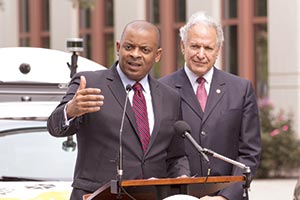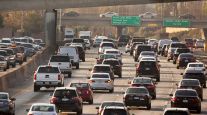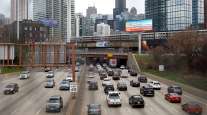DOT Supports Automation

This story appears in the Sept. 26 print edition of Transport Topics.
The U.S. Department of Transportation last week issued guidelines for testing and deployment of highly automated vehicles. Top administration officials said they want to promote development of self-driving technology to reduce crashes on the nation’s roadways.
They also want to increase mobility for millions of Americans who cannot drive due to disabilities or old age.
“Automated vehicles have the potential to save thousands of lives, driving the single biggest leap in road safety that our country has ever taken,” Transportation Secretary Anthony Foxx said in announcing the policy guidance. “This policy is an unprecedented step by the federal government to harness the benefits of transformative technology by providing a framework for how to do it safely.”
Rep. Bill Shuster (R-Pa.), chairman of the House Transportation and Infrastructure Committee, said he has seen firsthand the speed at which autonomous vehicle technology has advanced, having recently participated in a test drive of a vehicle developed at Carnegie Mellon University.
“We have seen significant investment in autonomous systems by large technology companies, startups, traditional automakers and ride-sharing services,” Shuster said. “The volume of investment by such a wide range of interests removes any doubt that autonomous vehicles are the future.”
Highway safety advocates and vehicle manufacturers welcomed the move to establish federal oversight of the fast-developing technology, but some trucking industry leaders expressed concern over how the policy was developed.
“It is disconcerting that the department and the administration have developed these guidelines with virtually no involvement from the trucking industry,” American Trucking Associations President Chris Spear said.
“If cars and trucks move toward autonomous technologies, they will need to be capable of interacting safely, whether through vehicle- to-vehicle technology or communication through other means,” he said in a letter to Foxx.
Spear said he is concerned about how autonomous vehicle technologies might affect a driver’s hours of service and the adoption of platooning, where electronic connections between rigs allow trucks to follow more closely to conserve fuel. He also is concerned about other safety systems, such as automated braking.
“Some freight company leaders are predicting a day when professional truck drivers are more like pilots — heavily involved in ‘taking off’ from the terminal and ‘landing’ at the destination but engaging an autopilot on open stretches of highway,” Spear noted.
At a press conference in Washington, Foxx said the new automated vehicle policy is a product of “significant” public input and stakeholder discussions, including two public meetings this year and an open docket for comments. He said the department will solicit additional public comments for the next 60 days and that the policy will be updated annually.
The new policy has three major thrusts:
• To give manufacturers and other entities involved in the development of automated vehicles a way to document performance of vehicles using a 15-point checklist of safety functions.
• To clarify the role of federal and state agencies by maintaining responsibility for licensing of drivers and enforcement with states while giving the federal government, principally the National Highway Traffic Safety Administration, responsibility for setting safety standards and conducting recalls.
• To expand the use of exemptions from current Federal Motor Carrier Safety Administration standards to allow for deployment of vehicle test fleets with new designs, plus new authority for DOT and NHTSA to approve vehicles and technologies before they are allowed to be sold in the market.
NHTSA Administrator Mark Rosekind said automated driving technologies potentially could prevent the overwhelming majority of crashes caused by human choice or error. In 2015, the nation saw a big increase in highway fatalities with 35,092 people killed, a 7.2% increase from 2014.
A number of companies and organizations expressed support for government’s policy guidelines.
“This is an important step forward in establishing the basis of a national framework for the deployment of self-driving vehicles,” said David Strickland, general counsel for the Self-Driving Coalition for Safer Streets, a group whose members include Ford Motor Co., Google, Lyft, Uber Technologies and Volvo Cars.
Wolfgang Bernhard, head of Daimler Trucks’ global commercial vehicles division, said he welcomes the fact that DOT is issuing guidance rather than hard and fast rules because autonomous technology is changing so fast. “This is a first step toward fully autonomous vehicles that trucks are prone to have before you have cars without a steering wheel in downtown San Francisco,” Bernhard told reporters at the IAA Commercial Vehicles Show in Hanover, Germany.
DOT’s actions also will help to clarify emerging legal issues, said Jennifer Mason, director of client relations for Roberts Perryman, a law firm in St. Louis.
“The biggest issue is the possibility of hacked software, which has already happened in cars,” Mason said.
The question of who is responsible in a crash involving driverless vehicles also must be addressed. “It’s a whole new world,” she said.
A spokesman for the International Brotherhood of Teamsters expressed concern about the effects of self-driving vehicles on drivers.
“It’s important that there be a full understanding in testing of the potential benefits and risks, as well as limitations — our current infrastructure being one,” union spokesman Ted Gotsch said.




